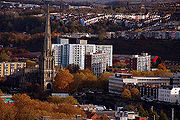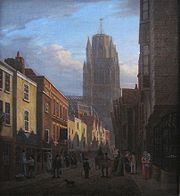
Redcliffe, Bristol
Encyclopedia
Redcliffe, also known as Redcliff, is a district of the English
port city of Bristol
, adjoining the city centre
. It is bounded by the loop of the Floating Harbour
(including Bathurst Basin) to the west, north and east, the New Cut
of the River Avon
to the south. Most of Redcliffe lies within the city ward of Lawrence Hill
, although the westernmost section, including the cliffs and hill from which the area takes its name, is in Cabot ward
.
Redcliffe takes its name from the red sandstone cliffs which line the southern side of the Floating Harbour, behind Phoenix Wharf and Redcliffe Wharf. These cliffs are honey-combed with tunnels constructed both to extract sand for the local glass making
industry and to act as store houses for goods. Part of the last remaining glass kiln
in the area is now the Kiln Restaurant of the Ramada Bristol City Hotel in Redcliffe Way.
The parish church of St. Mary Redcliffe is one of Bristol's best known churches, with a spire soaring to a height of 292 ft (90m).

, although there were numerous ferries.
In the twelfth century Robert Fitzroy gave the Knights Templar
part of Redcliffe, which then became known as Temple Fee. The Templars were granted the power to hold courts and execute felons. This right passed, along with the fee, to the knights of St. John of Jerusalem after the suppression of the Templars.
 Early recorded industries in Redcliffe include weaving
Early recorded industries in Redcliffe include weaving
, fulling
, dyeing
. It is likely that fulling and dyeing, which could be quite noxious processes were not welcome within the town walls of Bristol and so were established here, nearby but outside the city walls.
In the 13th century Redcliffe and Bristol underwent a rapid expansion, in King Henry III
's reign due to a 'major harbour improvement' (Broad Quay or St. Augustines Reach). This involved the construction of a 'Great Ditch' which formed a new course for the River Frome
through St Augustine's Marsh. This provided more space for ships to moor and new quays were built. In the same period a stone bridge, Bristol Bridge, was constructed. To achieve this the river Avon was diverted through Redcliffe, along the line of the 'Portwall' and solid stone foundations laid for the bridge, behind wattle and daub coffer dams. "The men of Redcliffe" were enjoined to help these projects by Henry III.
A hundred years later, in 1373, Redcliffe became part of Bristol to become the city and county of Bristol. The granting of county status was important as it meant that legal disputes no longer had to be taken to courts in Gloucester
or Ilminster
in Somerset
.
England
England is a country that is part of the United Kingdom. It shares land borders with Scotland to the north and Wales to the west; the Irish Sea is to the north west, the Celtic Sea to the south west, with the North Sea to the east and the English Channel to the south separating it from continental...
port city of Bristol
Bristol
Bristol is a city, unitary authority area and ceremonial county in South West England, with an estimated population of 433,100 for the unitary authority in 2009, and a surrounding Larger Urban Zone with an estimated 1,070,000 residents in 2007...
, adjoining the city centre
Bristol city centre
Bristol city centre is the commercial, cultural and business centre of Bristol, England. It is the area south of the central ring road and north of the Floating Harbour, bounded north by St Pauls and Easton, east by Temple Meads and Redcliffe, and west by Clifton and Canon's Marsh...
. It is bounded by the loop of the Floating Harbour
Bristol Harbour
Bristol Harbour is the harbour in the city of Bristol, England. The harbour covers an area of . It has existed since the 13th century but was developed into its current form in the early 19th century by installing lock gates on a tidal stretch of the River Avon in the centre of the city and...
(including Bathurst Basin) to the west, north and east, the New Cut
New Cut (Bristol)
The New Cut is an artificial waterway which was constructed between 1804 and 1809 to divert the tidal river Avon through south and east Bristol, England. This was part of the process of constructing Bristol's Floating Harbour, under the supervision of engineer William Jessop...
of the River Avon
River Avon, Bristol
The River Avon is an English river in the south west of the country. To distinguish it from a number of other River Avons in Britain, this river is often also known as the Lower Avon or Bristol Avon...
to the south. Most of Redcliffe lies within the city ward of Lawrence Hill
Lawrence Hill, Bristol
Lawrence Hill is an electoral ward of Bristol, United Kingdom. It takes its name from a small area just to the east of the city centre, and includes the districts of Barton Hill, St Philips Marsh and Redcliffe, Temple Meads and parts of Easton and the Broadmead shopping area.-History:It is the most...
, although the westernmost section, including the cliffs and hill from which the area takes its name, is in Cabot ward
Cabot, Bristol
Cabot is a council ward that covers the centre of Bristol. It gets its name from the Cabot Tower - a memorial tower on Brandon Hill that was built to commemorate John Cabot's voyage and "discovery" of North America.-Areas:...
.
Redcliffe takes its name from the red sandstone cliffs which line the southern side of the Floating Harbour, behind Phoenix Wharf and Redcliffe Wharf. These cliffs are honey-combed with tunnels constructed both to extract sand for the local glass making
Glass
Glass is an amorphous solid material. Glasses are typically brittle and optically transparent.The most familiar type of glass, used for centuries in windows and drinking vessels, is soda-lime glass, composed of about 75% silica plus Na2O, CaO, and several minor additives...
industry and to act as store houses for goods. Part of the last remaining glass kiln
Kiln
A kiln is a thermally insulated chamber, or oven, in which a controlled temperature regime is produced. Uses include the hardening, burning or drying of materials...
in the area is now the Kiln Restaurant of the Ramada Bristol City Hotel in Redcliffe Way.
The parish church of St. Mary Redcliffe is one of Bristol's best known churches, with a spire soaring to a height of 292 ft (90m).

History
Redcliffe was originally part of the manor of Bedminster, held by the earls of Gloucester, divided from Bristol by the river Avon. Relatively deep water alongside the outcrops of red sandstone upon which St Mary Redcliffe sits encouraged the development of wharves. There existed some rivalry between residents and merchants of Redcliffe and those of Bristol. The only fixed crossing of the river was Bristol BridgeBristol Bridge
Bristol Bridge is an old bridge over the floating harbour in Bristol, England, the original course of the River Avon.-History:Bristol's name is derived from the Saxon 'Brigstowe' or 'place of the bridge', but it is unclear when the first bridge over the Avon was built. The Avon has the 2nd highest...
, although there were numerous ferries.
In the twelfth century Robert Fitzroy gave the Knights Templar
Knights Templar
The Poor Fellow-Soldiers of Christ and of the Temple of Solomon , commonly known as the Knights Templar, the Order of the Temple or simply as Templars, were among the most famous of the Western Christian military orders...
part of Redcliffe, which then became known as Temple Fee. The Templars were granted the power to hold courts and execute felons. This right passed, along with the fee, to the knights of St. John of Jerusalem after the suppression of the Templars.

Weaving
Weaving is a method of fabric production in which two distinct sets of yarns or threads are interlaced at right angles to form a fabric or cloth. The other methods are knitting, lace making and felting. The longitudinal threads are called the warp and the lateral threads are the weft or filling...
, fulling
Fulling
Fulling or tucking or walking is a step in woolen clothmaking which involves the cleansing of cloth to eliminate oils, dirt, and other impurities, and making it thicker. The worker who does the job is a fuller, tucker, or walker...
, dyeing
Dyeing
Dyeing is the process of adding color to textile products like fibers, yarns, and fabrics. Dyeing is normally done in a special solution containing dyes and particular chemical material. After dyeing, dye molecules have uncut Chemical bond with fiber molecules. The temperature and time controlling...
. It is likely that fulling and dyeing, which could be quite noxious processes were not welcome within the town walls of Bristol and so were established here, nearby but outside the city walls.
In the 13th century Redcliffe and Bristol underwent a rapid expansion, in King Henry III
Henry III of England
Henry III was the son and successor of John as King of England, reigning for 56 years from 1216 until his death. His contemporaries knew him as Henry of Winchester. He was the first child king in England since the reign of Æthelred the Unready...
's reign due to a 'major harbour improvement' (Broad Quay or St. Augustines Reach). This involved the construction of a 'Great Ditch' which formed a new course for the River Frome
River Frome, Bristol
The River Frome is a river, approximately long, which rises in Dodington Park, South Gloucestershire, and flows in a south westerly direction through Bristol, joining the former course of the river Avon in Bristol's Floating Harbour. The mean flow at Frenchay is The name Frome is shared with...
through St Augustine's Marsh. This provided more space for ships to moor and new quays were built. In the same period a stone bridge, Bristol Bridge, was constructed. To achieve this the river Avon was diverted through Redcliffe, along the line of the 'Portwall' and solid stone foundations laid for the bridge, behind wattle and daub coffer dams. "The men of Redcliffe" were enjoined to help these projects by Henry III.
A hundred years later, in 1373, Redcliffe became part of Bristol to become the city and county of Bristol. The granting of county status was important as it meant that legal disputes no longer had to be taken to courts in Gloucester
Gloucester
Gloucester is a city, district and county town of Gloucestershire in the South West region of England. Gloucester lies close to the Welsh border, and on the River Severn, approximately north-east of Bristol, and south-southwest of Birmingham....
or Ilminster
Ilminster
Ilminster is a country town and civil parish in the countryside of south west Somerset, England, with a population of 4,781. Bypassed a few years ago, the town now lies just east of the intersection of the A303 and the A358...
in Somerset
Somerset
The ceremonial and non-metropolitan county of Somerset in South West England borders Bristol and Gloucestershire to the north, Wiltshire to the east, Dorset to the south-east, and Devon to the south-west. It is partly bounded to the north and west by the Bristol Channel and the estuary of the...
.

